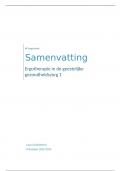Samenvatting
Summary PSY3370 case 5 depression and burnout
case/taak 5 van het vak hormones, the brain and behaviour wat onderdeel is van de bachelor psychologie en advanced minor in psychology. Heb zelf een 8,5 gehaald voor het tentamen.
[Meer zien]













